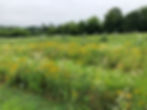
Sustainable, Regenerative Farming Practices
Our fruit and vegetable farm builds the soil and supports pollinator habitats.
Chocolates and Tomatoes Farm in Middletown, Maryland centers around sustainable, regenerative farming practices to grow fruits, vegetables, and herbs. On our 11-acre farm, we are a friend to the soil, water, pollinators and the environmental. Sustainable, regenerative practices include DOING certain things to build the environment and NOT DOING certain things that hurt the environment.
Things we do to build the environment
Host bees: We allow a beekeeper to put hives in our fields. Bees help our crops grow.
Plant cover crop: Cover crops are plants that give back to the soil, control erosion, and filter the water. We plant them in between the rows where we are growing crops for sale. We also plant them in the rows when the eating crops are done. We mostly use buckwheat, clover, and field peas.
Use drip tape for watering: The water goes right to the roots of our plants. This cuts down on weeds and decreases the amount of water we have to use because there is less evaporation.
Use row cover: Row cover is a special fabric that lets in sunlight and water but keeps out bugs and helps make the soil a little warmer for the plants. We use it to support plants when they are small and their most vulnerable.
Use a high tunnel for some crops: Some crops grow best when the rain doesn't land on them directly and when they stay warmer all the time. High tunnels provide that extra protection and they cut down on soil erosion.
Things we don't do that hurt the environment
No chemicals to kill insects: We use beneficial insects, like ladybugs, to eat other insects that harm our plants. We also try to keep the harmful insects off of the plants (see above). We walk around the field and look for the "bad" bugs and squish them with our fingers when needed.
No chemicals to kill weeds: Many of the things we do to build the environment also help with controling the weeds. Sometimes you just have to get out there an pull them out or use a weed-eater because we can't stop them all.
Gallery










